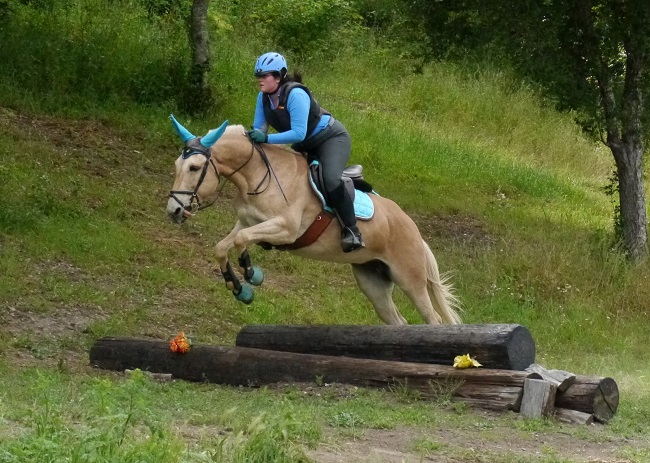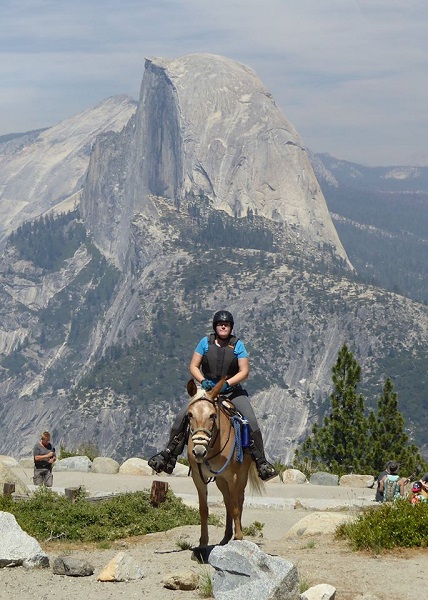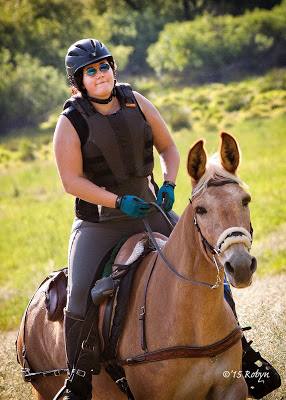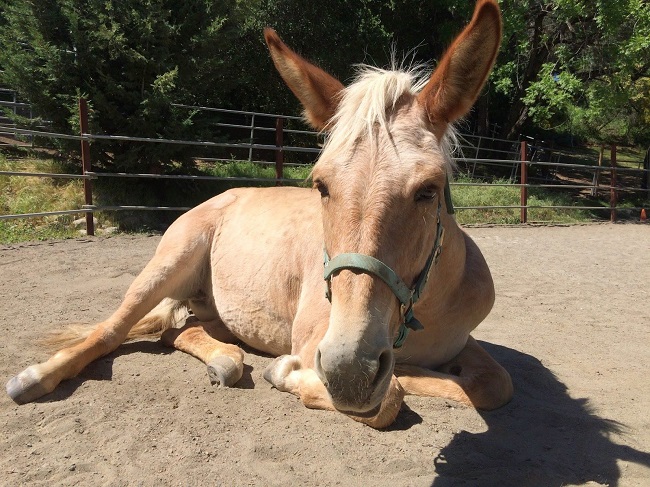Followers of the Mulography Facebook page will probably have seen me sharing a lot of Nilla-related things from Do It Yourself Horse Ownership – but how could I not, she’s so cool! I was thrilled to find a blog that not only featured a mule but was also regularly updated. That seems to be quite a rare thing (if you know of any others, please share them with me!), and I am really pleased to be able to bring you a Nilla Mule Tale. It’s a good one, too.
Unless otherwise stated, all images in the post are © copyright to Do It Yourself Horse Ownership.

1. Please introduce us to your mule!
Nilla is a 12 year old, 15hh palomino mule out of a palomino Paint mare and UC Davis’s Action Jackson. I’ve had her for a little over two years now and have been slowly, and painstakingly, making her into an eventing mule.

2. How did you meet her?
I had always wanted a mule, but kept buying horses because mules are so hard to find. Especially mules that are tall enough for me to ride. After a back injury, I needed to sell my big, bouncy warmblood so I finally decided to get serious about buying a mule. Because mules are rarer than horses, I was looking all across the country. In addition to mules being less common, I had a lot of additional search criteria. Because of my height, I needed something 15hh or higher, which is harder to find in mules. I also hate chestnuts, and a lot of mules are chestnut. So that cut down on my options. We were considering flying to other states to look when I saw Nilla’s ad. She was actually less than 90 minutes away. I don’t actually like palomino as a color, and Nilla had been living in an unsheltered pasture for years. She looked like a yak. She was green and barely trained and just barely met my height requirement, but I figured she was so close, we should at least go look at her.
The trial ride was interesting. She was barely broke and had been unused for years. She literally had to have a piece of bailing twine tied through the bit and over her nose to keep her from putting her tongue over the bit. Steering was questionable and her version of cantering was to crow-hop (mini bucks) every single step. But she was very, very friendly. A lot of mules are one person mules; they like their human and that’s it. Nilla liked everyone. Her nearby location and friendliness were really her only redeeming features. Looking back on it, I’m incredibly lucky she’s turned out as good as she has.

3. What do you do with her, and what are your plans for the future?
We do a little bit of everything. Our main training focuses are dressage and eventing. Mules are legal in dressage, but not in eventing, which is unfortunate for Nilla as she loves jumping and hates dressage. However, schooling shows can give me permission to show her so we mostly stick to the schooling circuit. I do hope to break out into rated dressage shows this year. In addition to showing, we also do a lot of trail riding and have dabbled in endurance riding. I actually think Nilla could do a lot more endurance as she’s naturally very good at it. I have a bad ankle and knee though and will probably never do more than a 25 mile ride. We do a little bit of everything and I’m always looking to try new things with her. I’d really like to try cattle work in the future. My main goal with Nilla is to be a well-rounded jack-of-all-trades mule.
 Image © copyright Robyn Burgess
Image © copyright Robyn Burgess
4. Can you share a story that you feel sums up your mule and/or your relationship with her?
Nilla and I have an interesting and sometimes contentious relationship. One of the things that’s really great about her is that as difficult as she can be, she’s reliable. I like to say I have the same (half) ass at home as I do away. A year ago, we went to our first combined test. I hadn’t really thought much about the jumping part in advance because I was concentrating so hard on the dressage test. I was worried about memorizing the test and getting Nilla to look her best. Well, we got through the dressage test and walked the jumping course and I realized that all the jumps were beautifully decorated. Our home arena didn’t have a single flower or painted pole in it, let alone picket fences, brick walls, and flower boxes. I was freaking out a little bit flashing back to my years of riding high-strung hunter-jumpers who would spook at a stray flower and thinking why didn’t I prepare for this?
Thankfully, Nilla didn’t care at all. She strolled into that arena and packed my terrified self around the jumps like a good little mule. She was calm and quiet for the whole show even though it was her first time traveling by herself, the first time I rode in her in an indoor arena, the first time she’d seen mirrors, and her first time seeing decorated jumps. She just went there and got her job done like a seasoned show mule. And we got 2nd place with a clear jumping round.

5. What’s the most important thing you’ve learnt as a mule owner, and what piece of advice would you give to someone new to mules?
The thing I tell most people is: don’t get one. We go to a lot of shows and events and Nilla cleans up really well. She’s excellent at shows; she doesn’t get excited or act up. I always show easier than I’m schooling at home and we have won a lot or classes and ribbons. Because she’s unique and pretty, a lot of people will tell me how much they love her and they want to get a mule for their next horse. And I tell them they shouldn’t. Show day is a facade. It is for everyone, not just for me as a mule rider. What you see on that day is 2+ years of blood, sweat, and time sunk into training. It took me one year to be able to be able to canter her under saddle. It’s taken another year to feel okay about doing that at a show. I spent years training horses. In the past, I would take an OTTB or even an unbroke rescue horse and get it to the stage that I’m at now in a matter of months. Not years. And from the mule trainers I’ve spoken to, I’m lucky. Nilla is considered easy for a mule.
All that said, if you have your heart set on a mule – and trust me, I understand that desire – my biggest piece of advice is patience. Go into your adventure knowing it’s going to take a long time. That the struggle will be real. That you’ll seriously contemplate selling your mule and buying a nice, easy horse. That there will be days where it’s no fun and you don’t know why you’re doing this, and your trainer wonders why you’re doing this, and your S.O. wonders how they got dragged into this. You will need professional help. I would highly recommend finding someone who has trained mules before to help you. The advice and training I’ve received is the only reason I’ve gotten as far as I have. Have patience, have realistic expectations, and don’t give up. There’s nothing as stubborn as a mule, so you’ll need to be just as stubborn if you want to succeed. A good mule is worth her weight in gold. The reward can be amazing; you just have to get there.
If you would like your mule to be featured here, or if you have a mule story that you would like to tell, then please contact me either via this blog, message me on my Mulography Facebook page, or email me at: herecirm (at) gmail.com. I would particularly like to hear from UK mule owners (purely because Mulography is about owning a mule in the UK), but am more than happy to take worldwide submissions!

Thanks so much for sharing!